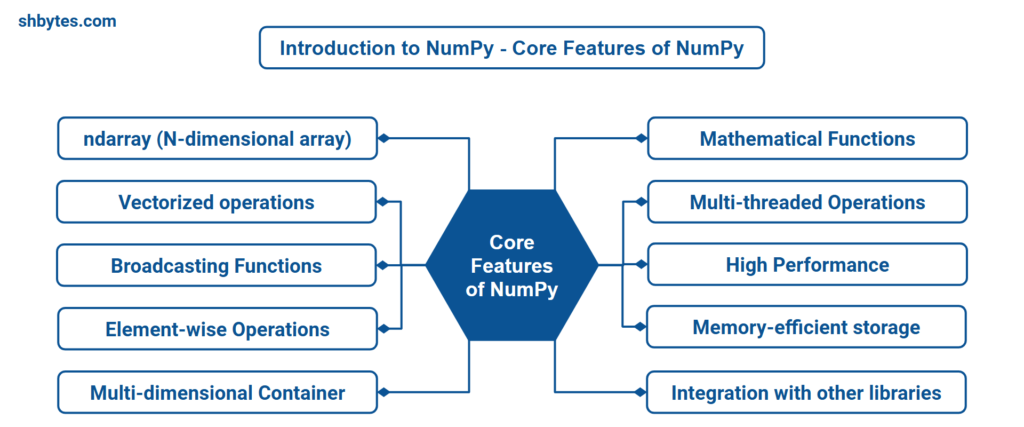Introduction to NumPy
NumPy stands for Numerical Python. It is an open-source Python library, which is predominantly mostly used for numerical computations in Python. It provides mathematical functions applicable to work with multi-dimensional arrays and matrices. It is a powerful tool to handle large data structures and allows performing complex arithmetic calculations. It has built-in computational features from programming languages like C and Fortran. NumPy allows programmers to execute numerical operations and serves as the foundational base for other popular Python libraries like Pandas, SciPy, Matplotlib, and scikit-learn. In this tutorial, we will learn about:
- The Core Features of NumPy
- Why NumPy is Faster Than Lists
- Which Language is NumPy Written In?
- Why use NumPy
- Importance of NumPy in different Fields.
Core Features of NumPy

- ndarray (N-dimensional array): NumPy’s main feature is the
ndarray.ndarrayobjects for efficiently storing and manipulating large arrays and matrices of numerical data.ndarraycan have any number of dimensions, ranging from 1D (a vector) to multi-dimensional arrays (matrices, tensors, etc.). - Vectorized operations: NumPy allows fast computation through vectorised operations, which avoid the need for awkward for-loops. This is made possible through the use of ufuncs, or universal functions, which enable you to perform element-wise operations on arrays.
- Element-wise Operations: Using NumPy we can perform mathematical functions across all elements of an array without needing explicit loops. Operations like addition, subtraction, multiplication, division, trigonometric, logarithmic, and exponential functions are performed on all elements of the array.
- Broadcasting: NumPy we can perform mathematical operations on arrays of different shapes like e.g., 1-D, 2-D, 3-D, etc. During these operations smaller arrays are expanded to match the shape of larger arrays. This feature of NumPy is known as broadcasting.
- Memory-efficient storage: Compared to Python’s native data types such as lists and tuples, NumPy arrays are much more memory-efficient, because NumPy arrays store data in contiguous blocks of memory, making it faster to access and manipulate.
- Mathematical functions: NumPy library provides multiple mathematical functions from different domains like linear algebra, statistical distributions, random number generators, etc., along with trigonometric and logarithmic functions.
- Integration with other libraries: NumPy can be easily integrated with other Python libraries like SciPy, Pandas, Matplotlib and machine learning frameworks, TensorFlow and PyTorch.
- Multi-threaded Operations: NumPy utilizes multi-threaded operations to perform computations faster. This improves the performance of the code.
- Being an open-source Python library, NumPy has a great community support.
Why NumPy is Faster Than Lists?
If we will perform a similar operation using standard Python Lists and NumPy Array, we will find NumPy arrays perform the operation much faster than Python lists. This difference is more significant for large size arrays or lists. Here are some of the reasons for Why NumPy is faster than Lists.
- Efficient Memory Storage – NumPy stores its arrays in a single, continuous block of memory. It means all elements of a NumPy Array are stored in a sequential storage in memory. This allows to access and manipulate elements much faster.
- Locality of Reference – This means that NumPy arrays are in close locality of each other and can be easily referenced based on the another element memory location. This was programs can handle these elements more efficiently. Imagine it like grabbing a book from a book-shelf instead of picking up scattered pages from all over the room.
- Optimized for Modern Computers – NumPy is designed to make the most out of modern computer hardware. It can perform tasks using the fastest ways available on today’s CPUs, making it faster than standard lists.
In short, NumPy’s smart use of memory and its design to leverage modern computing power make it a better choice for data processing. This is why many people prefer it for handling big data tasks in Python.
Which Language is NumPy Written In?
NumPy is a popular Python library used for numerical computations, but it’s not just written in Python. Here’s a breakdown of its composition:
- Python – NumPy provides a high-level interface for ease of use, which is written in Python. This makes it simple and intuitive for Python programmers to use.
- C and C++ – The core of NumPy, which performs mathematical operations and require faster computation is written in C and C++. These languages are much faster than Python for performing complex mathematical operations.
- Why This Combination?
- Python is easy to read and write, making it great for developing the interface and overall structure of the library.
- C and C++ are powerful and efficient, making them perfect for the heavy lifting of numerical computations.
This combination of languages allows NumPy to be both user-friendly and extremely fast, giving you the best of both worlds.
Why use NumPy?
Performance: NumPy is faster than lists. NumPy arrays are more efficient in memory and quicker than Python lists because they are implemented in C programming language and are stored in contiguous blocks of memory. This makes NumPy perfectly suitable for dealing with large datasets and computationally intensive tasks.
Vectorization: NumPy allows fast computation through Vectorization, which avoid the need for awkward for-loops. This is made possible through the use of ufuncs, or universal functions, which enable you to perform element-wise operations on arrays.
Compatibility and Integration: NumPy is compatible to work with other scientific computation libraries and frameworks.
Versatility: NumPy library is very versatile. It supports basic array operations to advanced mathematical operations like matrix operations, linear algebra, statistical, logarithmic, exponential etc.
Importance of NumPy in different Fields
Data Science and Data Analysis
- In data science, NumPy is used for data cleaning tasks like filling missing values, filtering, sorting, transforming data with array slicing, indexing and broadcasting.
- NumPy helps with statistical data analysis using statistical functions like median, mean , variance and standard deviation.
- NumPy is also quite useful in working with time series data and performing operations over different time intervals.
Scientific Research
- NumPy has in-built tools to support scientific research. Such as performing simulations in scientific subjects such as Physics, Chemistry, Biology etc. NumPy has a random module that can stimulate experiments like rolling and flipping coins.
- NumPy can also be applied to solve advanced Engineering Mathematics problems such as ordinary and partial differential equations etc. Numerical methods in NumPy can be used in structural analysis and Signal Processing.
Machine Learning
- The efficient matrix multiplication and other linear algebra computations with NumPy is crucial for many algorithms in machine learning. These include the dot product as well as eigenvalue and matrix decompositions.
- Numpy is essential to understand the algorithm and Neural networks as well. Numpy also fits seamlessly with Scikit-learn, TensorFlow, Pytorch, and other libraries,
- NumPy is used for the optimization tasks during the training of a machine learning model.
- NumPy is used for implementing gradient descent algorithms, which are of great importance for models such as linear regression, logistic regression and neural networks training.
Artificial Intelligence (AI)
- Neural Networks: NumPy makes use of multidimensional ndarrays, similarly TensorFlow and PyTorch libraries employ the concept of multidimensional arrays. However, in this case, NumPy is more appropriate for prototyping of the AI models and for performing matrix multiplication, or transformations of matrices.
- Image Processing: In Deep learning, NumPy also helps for AI based image processing by changing the pixels color, applying filters and changing images dimensions by resizing, rotating and cropping.
Deep Learning
- Data Representation: In deep learning, data such as images, videos, and text are often represented as multi-dimensional arrays (tensors). NumPy plays a role in pre-processing and transforming this data for use in deep learning models.
- Batch Operations: NumPy is used to handle batch processing in deep learning, which allows multiple data points to be passed through the model at once to speed up training.
Finance and Economics
- Financial Modelling: A wide variety of financial models such as portfolios and risk assessments may use NumPy for financial simulations and forecasting.
- Time-Series Analysis: NumPy is also a common tool for modification and analysis of time-series data which could be stock prices, economic indicators, and forecasting. NumPy can identify patterns in historical market data like stock prices and market sales.
Engineering
- Control Systems: In engineering, NumPy is used for control systems design and analysis. Matrices are used in control systems and operations such as eigenvalue evaluation for assessing system stability.
- Simulations: Problems in structural engineering, electrical engineering, fluid mechanics, as well as mechanical systems that require various mathematical models on a larger scale are solved by engineers through the use of NumPy.
- Signal Processing: Algorithms practiced by engineers in telecommunications or electrical engineering are known to be used by NumPy for various purposes including filtering and noise reduction to digital signals.
Robotics
- Kinematics and Dynamics: NumPy is used with applications in modeling the kinematics and dynamics of robotic systems. It handles matrix and vector operations for computing transformations, velocities, and forces.
- Path Planning: NumPy is also useful for implementing algorithms for path planning and navigation, helping robots determine the best route in a given environment.
Summary
In this tutorial, we learned about NumPy, an open-source Python library, which is predominantly mostly used for numerical computations in Python. This tutorial covers introduction of NumPy, the core features of NumPy, Why use NumPy? and Importance of NumPy in different Fields.
In the next article we will learn How to Install NumPy on Windows, Linux and Mac.
Related Topics
- Create Arrays with Predefined Values using np.zeros(), np.ones(), np.full() and np.empty()Create Arrays with Predefined Values NumPy library provides various functions to create arrays with predefined values. While creating an array, these NumPy functions helps to initialize the arrays with initial values. In last tutorial, we learned about Key Features of NumPy Arrays in Python. In this article, we will learn about 4 functions to create…
- How to Install NumPy on Windows, Linux and Mac: step-by-step guideWe can install NumPy on all major operating systems such as Windows, Linux and macOS. NumPy installation process is very simple and can be done using pip, which is the Python package installer. Here are the steps to install NumPy on Windows, Linux and Mac operating systems. Install NumPy on Windows, Linux and Mac Prerequisites…
- Introduction to NumPy: Core Features and Importance in different FieldsIntroduction to NumPy NumPy stands for Numerical Python. It is an open-source Python library, which is predominantly mostly used for numerical computations in Python. It provides mathematical functions applicable to work with multi-dimensional arrays and matrices. It is a powerful tool to handle large data structures and allows performing complex arithmetic calculations. It has built-in computational features…
- np.linspace(): Create Arrays with Evenly Spaced Numbers in NumPy (with Example Programs)NumPy is a powerful Python library for numerical computing, and np.linspace() is one of the most useful functions for generating arrays of evenly spaced values within a specified range. In previous tutorials, we learned about Key Features of NumPy Arrays in Python. This tutorial will provide a step-by-step guide to understand how to use np.linspace() effectively,…
- np.logspace(): Create Array of Evenly Spaced Numbers on Logarithmic Scale (with Example Programs)NumPy is a powerful Python library for numerical computing, and np.logspace() is one of the powerful function to create array of evenly spaced numbers on logarithmic scale. In previous tutorials, we learned about Key Features of NumPy Arrays in Python. This tutorial will provide a step-by-step guide to understand how to use np.logspace() effectively, with examples.…
